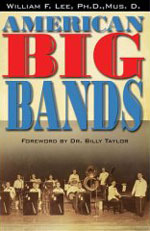Home » Jazz Articles » Book Review » American Big Bands
American Big Bands
 American Big Bands
American Big Bands William F. Lee III
Softcover; 376 pages
ISBN: 0-634-08054-7
Hal Leonard Corporation
2006
With thumbnail sketches of all the popular big bands from the Swing Era and many not-so-well-known bands too, William F. Lee III provides a valuable guide for those who need to know or who simply want to know.
In his brief descriptions of bands such as those led by Benny Goodman, Count Basie, Woody Herman, Duke Ellington, Les Brown, Guy Lombardo, Lawrence Welk and Glenn Miller (650 bands in all), he follows a standard format. Each thumbnail sketch includes the following information where available:
- date and location of bandleader's birth
- bandleader's birth name, if applicable
- where the bandleader studied, if applicable
- which instrument(s) the bandleader played
- a list of singers who worked with the band
- a list of sidemen who worked with the band
- a list of labels for which the band recorded
- date and location of bandleader's death, if applicable
Throughout the text, we learn details that may not have been made available in previously published books. For example, we learn that Gail Storm sang with the Garewood Van Orchestra, Mike Douglas sang with the Kay Kyser band, and Merv Griffin sang with the Freddy Martin band. We also read that several big band sidemen turned to aviation during the 1941-45 war years. Saxophonist Frankie Trumbauer and bandleader Roger Wolfe Kahn became test pilots, and trumpeter Tutti Camarata was a flight instructor with the US Army Air Force.
There's a wealth more fascinating ephemera included. Bandleader Fred Waring invented the Waring Blender. Bandleader Vic Meyers (a drummer) served several terms as Lieutenant Governor of Washington. The Joe Gumin Orchestra recorded music in many languages, including English, Yiddish, Italian, Polish, German, Chinese, and Pig Latin. The Billy McDonald Orchestra was playing in Honolulu on December 7, 1941 (a significant date in US history).
Lee also includes pertinent facts from general history to accompany the bands under discussion. He adds, by year, a notice of when the first radio broadcasting station was established, when the theremin was introduced, when the first Latin band was formed in the US, as well as the years in which the Rhodes electronic piano, the LP, the Fender electronic steel guitar, and the Moog synthesizer first went on sale to the general public.
Curiously, some of the bands Lee includes weren't big bands at all. Those led by Al Hirt, Shorty Rogers, Stan Rubin, Charlie Mussen, Billy Maxted and Lu Watters, for example, were simply small to medium-sized combos. Yet the author includes thumbnail sketches for each of them and lists them as leaders of American big bands.
In his final chapter, Lee makes mention of several fusion bands, cites a few contemporary big bands, gives due credit to college and university big bands as well as several television bands, and lists a dozen ghost bands by name. There's no mention, however, of Wynton Marsalis, the Mingus Big Band, or several other significant organizations that have proven to be influential on the American big band scene in recent decades.
This printing is a first edition. It comes with numerous spelling errors and typographical mistakes that will, one hopes, be corrected for the second edition. However, each error serves as a serious distraction for the reader. The consistent use of "lead" in place of "led," and name bunglings such as Diana Shore, McKinndey's Cotton Pickers, Toota Mondello, Red Fio Rito, Dod Marmarosa, Manny Album, and Al Hurt make these errors difficult to overlook. They're distracting.
Despite this, American Big Bands would make a fine reference volume if only it included a proper index. While sidemen and band singers are mentioned with each thumbnail sketch, the book leaves the reader with no means for looking them up in the text. To find out which bands Stan Kenton or Benny Goodman played in before they became leaders, for example, one would have to re-read every paragraph. The only index provided is of the bandleaders themselves, and this lists only the page for that particular thumbnail sketch.
In his foreword, Dr. Billy Taylor remarks that "there is more information available on jazz than ever before. True, but for that information to be really useful, it needs to be relatively error-free, essentially complete, and organized in such a manner that we're able to call up data at our fingertips without too much trouble.
Comments
Tags
For the Love of Jazz
 All About Jazz has been a pillar of jazz since 1995, championing it as an art form and, more importantly, supporting the musicians who create it. Our enduring commitment has made "AAJ" one of the most culturally important websites of its kind, read by hundreds of thousands of fans, musicians and industry figures every month.
All About Jazz has been a pillar of jazz since 1995, championing it as an art form and, more importantly, supporting the musicians who create it. Our enduring commitment has made "AAJ" one of the most culturally important websites of its kind, read by hundreds of thousands of fans, musicians and industry figures every month.






















